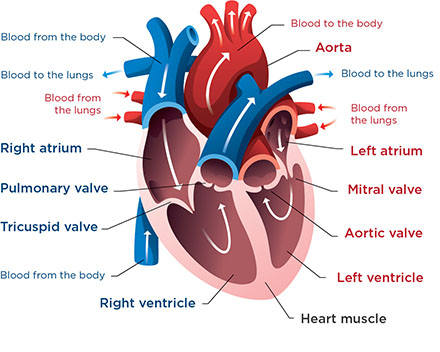Marfan Syndrome
What is Marfan syndrome?

This image shows a normal heart. In some children with Marfan syndrome, the aorta gets bigger (aortic dilation), which can weaken it and lead to bulging (aortic aneurysm) or tearing (aortic dissection). Or the mitral valve (between the heart’s left upper chamber and left lower chamber) is “floppy” and does not close right (mitral valve prolapse).
Marfan syndrome is a genetic disorder that affects the connective tissue, including the major blood vessels and the heart valves.
Connective tissue gives strength and support to many parts of the body. Besides the blood vessels and heart valves, other examples of connective tissue include the tendons, ligaments and cartilage.
In Marfan syndrome, the connective tissue is not normal. As a result, certain body parts are not as strong as they should be. This can cause a range of symptoms from very mild to severe and life threatening.
Heart problems are usually the most serious problems in children with Marfan syndrome. The walls of their major arteries tend to be weak. Often, their aorta is affected. If it is, the aorta gets bigger (dilates). This weakens the inner wall of the aorta.
A weak inner aortic wall can lead to an aneurysm (pronounced AN-yer-iz-em), an area where the aortic wall bulges outward. With severe aneurysms, the blood can leak through the tears and separate the layers of the aorta. This problem is called aortic dissection.
-
What causes Marfan syndrome?
Marfan syndrome is a genetic condition. Children who have Marfan syndrome are born with it.
Children can either inherit it from a parent or get it as a result from a genetic change that happened during pregnancy. It is important to identify which kind your child has. If a child inherited the condition, we know it also affects 1 or both of their parents. It might also affect their brothers and sisters.
Heart Center at Seattle Children's
Symptoms of Marfan Syndrome
The symptoms of Marfan syndrome may vary greatly, even among children in the same family. Symptoms can range from mild to severe.
Some children have no symptoms early in life. But as they grow, they develop common Marfan symptoms and traits.
-
Babies
If you have a family history of Marfan syndrome, tell your doctors this when you are pregnant so they can check your newborn closely for signs of the condition.
Newborns with signs of Marfan syndrome may have more serious heart problems than children diagnosed at an older age.
They may also have any of these problems:
- Mitral (pronounced MY-trahl) valve prolapse (valve between the heart’s left upper chamber and left lower chamber is “floppy” and does not close right)
- Blood that leaks backward through a heart valve (regurgitation)
- Breathing problems
-
Children
In children up to age 12, the most common symptoms of Marfan syndrome are with their bones. Your child may have these traits:
- Tall and thin frame
- Long, slender fingers, thumbs and toes
- Breastbone that caves inward or pushes forward
- Loose joints
- Scoliosis
- Flat feet
- Vision problems
- Heart murmur
-
Teenagers
Many of the traits of Marfan syndrome may be quite mild early in life and become easier to notice as your child grows. So, your child may not be diagnosed with Marfan syndrome until their teenage years.
Along with the common traits listed above for children, your teen’s doctor will be looking for these signs and symptoms:
- Heart murmur
- Arrhythmia
- Shortness of breath
Diagnosing Marfan Syndrome
To diagnose Marfan syndrome, the doctor will examine your child, checking for common traits of this condition.
The doctor will ask about your child’s health history and your family’s health history.
Your child will need an echocardiogram to look for signs of Marfan affecting their heart. The doctor will look for mitral valve prolapse (valve is “floppy” and does not close right) and aortic dilation (aorta is bigger than normal).
If there are concerns about your child’s vision, we will refer you to an eye doctor (ophthalmologist) to check for vision problems.
Early diagnosis matters for your child’s future health. When Marfan syndrome is diagnosed early, your child’s doctor can watch for problems that may need treatment. This may help prevent complications.
If your child has Marfan syndrome, their doctor may suggest genetic testing to see if parents or siblings have the condition. If you have questions about the risk of passing down the genetic change that causes Marfan syndrome, our Cardiac Genetics team can help. They offer consultation, evaluation and counseling.
Treating Marfan Syndrome
All children with Marfan syndrome need lifelong care to monitor their condition. Different symptoms may appear as your child gets older, so a doctor will want to watch for these.
Some children need medicines that lower their heart rate or blood pressure or both. Children who have major problems with their aorta, aortic valve or mitral valve may need surgery to repair or replace them. Pediatric cardiologists and cardiac surgeons in our Heart Center take care of children with these concerns.
To meet your child’s long-term heart-health needs, we have a special Adult Congenital Heart Disease Program to transition your child to adult care when they are ready.
Seattle Children’s also has programs to treat other health concerns related to Marfan syndrome, such as Orthopedics and Ophthalmology.
Marfan Syndrome at Seattle Children’s
-
The experts you need are here
- Though every child with Marfan syndrome was born with it, the signs may not appear until later in childhood. Our team of 40+ pediatric cardiologists diagnose and treat this condition in children of all ages, from infants to teenagers.
- Our pediatric cardiac surgeons perform more than 500 procedures yearly. Each has deep experience operating on babies, children and teens who have heart problems linked with Marfan syndrome.
- We also have a pediatric cardiac anesthesia team and a Cardiac Intensive Care Unit ready to care for children who undergo heart surgery.
- To help you understand your child’s condition — and the risk for other family members — our Cardiac Genetics Program combines the expertise of cardiologists, medical geneticists and genetic counselors.
- We connect you with specialists throughout Seattle Children’s based on your child’s health needs, such as Orthopedics if Marfan affects your child’s bones and Ophthalmology if it affects their eyes.
-
Among the nation’s top programs
- If your child needs surgery, such as to repair or replace their heart valve or aorta, our surgical outcomes are among the best in the nation year after year.
-
Care from birth through young adulthood
- We match your child’s care to their symptoms, and we take into account their age, growth and development. Some children with Marfan syndrome do not need treatment. Others need medicines, heart valve repair or replacement or other options. Your child’s treatment plan is custom-made for them.
- People with Marfan syndrome need lifelong checkups to monitor how the condition affects them over time. The Adult Congenital Heart Disease Program, shared by Seattle Children’s and the University of Washington, can help with care throughout your child’s life.
-
Support for your whole family
- We’re committed to your child’s overall health and well-being and to helping your child live a full and active life.
- Whatever types of care your child needs, we will help your family through this experience. We will discuss your child’s condition and treatment options in ways you understand and involve you in every decision.
- Our child life specialists know how to help children understand their illnesses and treatments in ways that make sense for their age.
- Seattle Children’s has many resources, from financial to spiritual, to support your child and your family and make the journey as smooth as possible.
- Many children and families travel to Seattle Children’s for heart surgery or other care. We help you coordinate travel and housing so you can stay focused on your child.
- Read more about the supportive care we offer.
-
Research to improve care
- Doctors and scientists at Seattle Children’s are working to advance treatment for Marfan syndrome and enhance quality of life for children growing up with this condition.
- We are researching the effects of obstructive sleep apnea on the heart and blood vessels of children with Marfan syndrome to help improve their care and long-term health.
- Our past research includes studies comparing medicines to reduce the chance that the aorta will enlarge. Better medical treatments may mean more children can avoid surgery.
Research and Clinical Trials
Seattle Children’s researchers are studying how obstructive sleep apnea might affect children with Marfan syndrome. We are looking into ways sleep apnea might affect a child’s heart, aorta or other aspects of their health. We do research like this to advance care for all children with Marfan syndrome and to improve their quality of life and well-being over the long term.
Learn more about research and clinical trials at Seattle Children’s.
Contact Us
Contact the Heart Center at 206-987-2515 for an appointment, second opinion or more information.
Providers, see how to refer a patient.
Related Links
- Adult Congenital Heart Disease
- Cardiac Genetics
- Heart Center
- Heart Surgery
- Ophthalmology
- Orthopedics
Paying for Care
Learn about paying for care at Seattle Children’s, including insurance coverage, billing and financial assistance.


